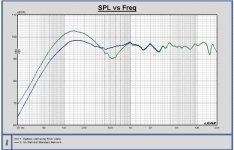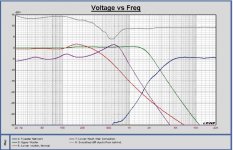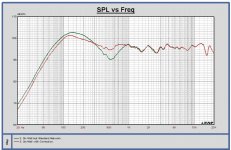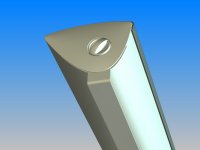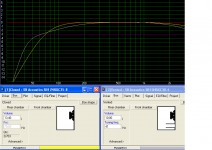How should be designed speaker, say ordinary 2-way standmount, so it plays nice almost against the wall? Like Rega R1, Linn Katan, Linn Kan are usually shown. About 5-10 cm from wall.
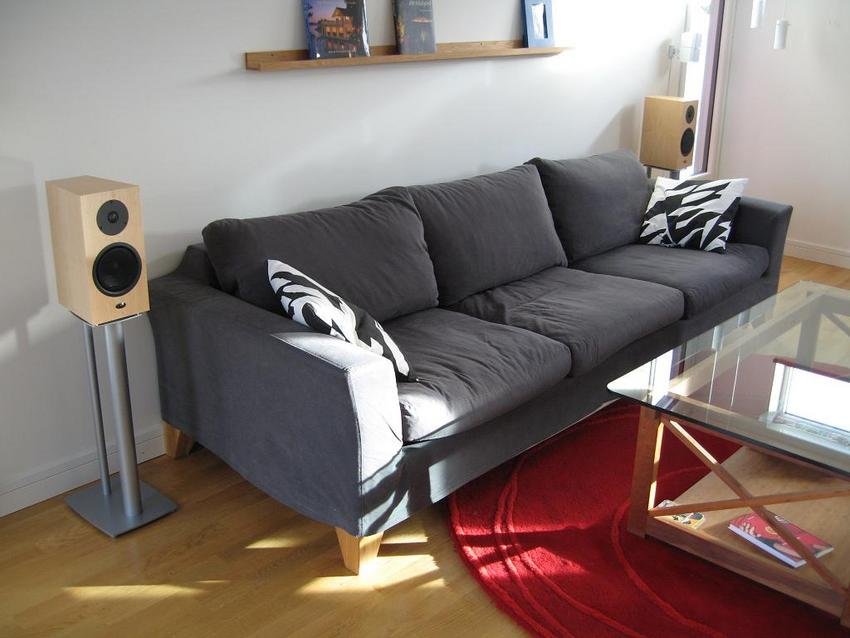
For little enclosure, speakers positioned like that do quite solid and fast sound because they radiate more 2pi because of back wall.
Should baffle step be corrected less or
bass tuning done as closed or
tune low Qts driver BR so bass response drops gradual for 200 Hz?
I think higher Qts driver is very no no!

For little enclosure, speakers positioned like that do quite solid and fast sound because they radiate more 2pi because of back wall.
Should baffle step be corrected less or
bass tuning done as closed or
tune low Qts driver BR so bass response drops gradual for 200 Hz?
I think higher Qts driver is very no no!
It would be better to design an on-wall speakers. With near-wall placement there's a sharp notch in the lower midrange because of the rear wall reflection. Also, there will indeed be an increase in bass because of 2pi radiation and stronger excitation of room modes. These to effects will significantly mess up the balance that way.
Nevertheless, it would probably be best to use less baffle step correction for a speaker near a wall to prevent it from sounding bass heavy. The midrange notch remains, but you really cannot do anything about that except adequate damping of the wall behind the speaker.
Nevertheless, it would probably be best to use less baffle step correction for a speaker near a wall to prevent it from sounding bass heavy. The midrange notch remains, but you really cannot do anything about that except adequate damping of the wall behind the speaker.
Last edited:
It would be better to design an on-wall speakers. With near-wall placement there's a sharp notch in the lower midrange because of the rear wall reflection. Also, there will indeed be an increase in bass because of 2pi radiation and stronger excitation of room modes. These to effects will significantly mess up the balance that way.
Nevertheless, it would probably be best to use less baffle step correction for a speaker near a wall to prevent it from sounding bass heavy. The midrange notch remains, but you really cannot do anything about that except adequate damping of the wall behind the speaker.
It would be but near wall standmounter has advantage that you can fine sound with placement. In-wall speaker is where it is screwed to wall.
BSC and bass must be different than free space speaker. Asking, who has designed these?
With near-wall placement there's a sharp notch in the lower midrange because of the rear wall reflection.
Of course the sharp notch issue is pretty much a technical measurement one and hardly an audible issue.
The BSC changes though are have to be measured and maybe corrected outside of that its not a big deal at all in having near wall speakers. Only the most pedantic of audiophiles will "Think" there is a problem but then again no one really wants to follow some of the crazy ideas they have anyways
BSC and bass must be different than free space speaker. Asking, who has designed these?
I only use active designs so that I can easily control placement and BSC. What are you really aksing though? You simply need to put your speaker design close to the wall and see what happens to the bass region then compensate for that change (if you choose too).
Of course the sharp notch issue is pretty much a technical measurement one and hardly an audible issue.
Since it occurs at a relatively low frequency, say 300 Hz, the reflection delay is very small (~ 3 ms) and the reflection is coincident with the speaker it probably is an audible issue. A listener might adapt to it because it is a constant colouration, though.
Wanna bet $$$ on normal playback audibility?? If its a sharp null then its easliy masked even at lower frequencies.....heck the room dominates everything below 300Hz anyways.
FWIW, I have done the controlled listening experiments on this exact topic. Before my room was treated I had speakers placement where the null was created around 200Hz or so. I did tests with panels that remove the null vs no panel. I even let friends try it out. They could not see me the speakers or the panels as I added them or removed them......there was a moment where someone thought "Hey, that is different/better".
Conclusion was that is purely a measurement issue and if someone is concerned over that then they have to solve it.
FWIW, I have done the controlled listening experiments on this exact topic. Before my room was treated I had speakers placement where the null was created around 200Hz or so. I did tests with panels that remove the null vs no panel. I even let friends try it out. They could not see me the speakers or the panels as I added them or removed them......there was a moment where someone thought "Hey, that is different/better".
Conclusion was that is purely a measurement issue and if someone is concerned over that then they have to solve it.
I designed an onwall system at PSB (the VS300) that had a switchable EQ for the rear wall bounce. Relative to the free field performance the on wall measurement was up considerably at LF with a strong dip at 200Hz or so. The rear wall dip was easily audible, as was the bass rise.
The trick was creating the EQ with a passive network. I ended up taking advantage of the 2 1/2way design and gave the lower woofer 2 very different rolloffs.
For this to work you need to have a fixed distance to the back wall. That would be the case for an onwall with its own bracket. (Not necessarily for a bookshelf speaker and stand "kind of" near the wall.)
The VS300 worked very well and was elegantly finished, yet never a big seller.
David S.
The trick was creating the EQ with a passive network. I ended up taking advantage of the 2 1/2way design and gave the lower woofer 2 very different rolloffs.
For this to work you need to have a fixed distance to the back wall. That would be the case for an onwall with its own bracket. (Not necessarily for a bookshelf speaker and stand "kind of" near the wall.)
The VS300 worked very well and was elegantly finished, yet never a big seller.
David S.
2pi loading can be compensated for. A really smart guy (ie not me) could probably design a vented enclosure that performs well in free space and then, if the vent is plugged, changes its response to one that is appropriate for half space. As for the mid cancellation dip, I guess the solution is a broad, preferably curvy baffle on the shallowest possible cabinet. This moves the dip upwards and, since octaves "grow larger" in frequency content as frequency goes up, it should become less and less noticeable. The LS3/5A, for example, would probably produce a dip at around 800 Hz if placed hard up against a wall.
On wall speaker correction
I found some curves for the VS300 with wall bounce correction.
The first curve shows the response of the system in free space and against the wall. Blue is free space and green is on-wall. Lots of LF lift from the boundary but at 500Hz the reflected source is 1/2 wave behind and heavy cancelation occurs. The curve is fairly wide as well as deep and was clearly audible as sucking the midrange out of voices. Note that there should be higher harmonics of cancelation but they are fairly minimal since the system directivity is rising.
The second curve shows a few different EQ curves. At the top is a gray difference curve between the 4 pi and 2 pi responses. The EQ needs to be the inverse of this curve to fix the on-wall response. The fix I used was via the 2 1/2 way woofer networks. Green shows the upper woofer response that never changes. Red and Purple are the "lower" woofer responses, achieved by network switching. Red is the normal free space or 4 pi response. Boundary correction comes from the Purple curve.
The final set of curve shows the on wall response without correction (green curve) and the boundary corrected curve in red. I didn't fully drop the bass response to flat (nobody complains about too much bass .)
.)
So there, it can be done. But remember that it only makes sense if you can guarantee that the boundary location is fairly consistent, as it would be with a wall bracket mounted system.
David S.
I found some curves for the VS300 with wall bounce correction.
The first curve shows the response of the system in free space and against the wall. Blue is free space and green is on-wall. Lots of LF lift from the boundary but at 500Hz the reflected source is 1/2 wave behind and heavy cancelation occurs. The curve is fairly wide as well as deep and was clearly audible as sucking the midrange out of voices. Note that there should be higher harmonics of cancelation but they are fairly minimal since the system directivity is rising.
The second curve shows a few different EQ curves. At the top is a gray difference curve between the 4 pi and 2 pi responses. The EQ needs to be the inverse of this curve to fix the on-wall response. The fix I used was via the 2 1/2 way woofer networks. Green shows the upper woofer response that never changes. Red and Purple are the "lower" woofer responses, achieved by network switching. Red is the normal free space or 4 pi response. Boundary correction comes from the Purple curve.
The final set of curve shows the on wall response without correction (green curve) and the boundary corrected curve in red. I didn't fully drop the bass response to flat (nobody complains about too much bass
So there, it can be done. But remember that it only makes sense if you can guarantee that the boundary location is fairly consistent, as it would be with a wall bracket mounted system.
David S.
Attachments
Here is picture of two different bass alignments. Another is fairly simple closed box Q 0,7, might integrate for room gain if gain begins quite low. Another is low tuned BR with low Qts driver. It has "bass tilt" which can be good if wall boosts higher than just natural room gain.
What do you think?
What do you think?
Attachments
ultimate near wall speaker designs come from E.J. Jordan, check it out:
This page gives details of the JX92S and JX53 Linear Array satellite systems. The angled baffle ensures that the axis of each driver crosses in front of the listener. The enclosures should be used flat against the back wall.
a flooder works well when placed against the wall too, check out this for example:
Experience 2: simply put on the floor, as close as possible from the back boundary (from post #669 and on)
This page gives details of the JX92S and JX53 Linear Array satellite systems. The angled baffle ensures that the axis of each driver crosses in front of the listener. The enclosures should be used flat against the back wall.
a flooder works well when placed against the wall too, check out this for example:
Experience 2: simply put on the floor, as close as possible from the back boundary (from post #669 and on)
ultimate near wall speaker designs come from E.J. Jordan, check it out:
This page gives details of the JX92S and JX53 Linear Array satellite systems. The angled baffle ensures that the axis of each driver crosses in front of the listener. The enclosures should be used flat against the back wall.
a flooder works well when placed against the wall too, check out this for example:
Experience 2: simply put on the floor, as close as possible from the back boundary (from post #669 and on)
Yes, those really are the ultimate. We stand in awe.
David S.
I found some curves for the VS300 with wall bounce correction.
The first curve shows the response of the system in free space and against the wall. Blue is free space and green is on-wall. Lots of LF lift from the boundary but at 500Hz the reflected source is 1/2 wave behind and heavy cancelation occurs. The curve is fairly wide as well as deep and was clearly audible as sucking the midrange out of voices. Note that there should be higher harmonics of cancelation but they are fairly minimal since the system directivity is rising.
The second curve shows a few different EQ curves. At the top is a gray difference curve between the 4 pi and 2 pi responses. The EQ needs to be the inverse of this curve to fix the on-wall response. The fix I used was via the 2 1/2 way woofer networks. Green shows the upper woofer response that never changes. Red and Purple are the "lower" woofer responses, achieved by network switching. Red is the normal free space or 4 pi response. Boundary correction comes from the Purple curve.
The final set of curve shows the on wall response without correction (green curve) and the boundary corrected curve in red. I didn't fully drop the bass response to flat (nobody complains about too much bass.)
So there, it can be done. But remember that it only makes sense if you can guarantee that the boundary location is fairly consistent, as it would be with a wall bracket mounted system.
David S.
Clever work David, impressive design. I'll have to take back my comment that nothing can be done about the midrange dip!
How far was the woofer cone away from the back wall?
Far enough to create a dip at 500Hz.
Who can answer the question?
David S.
Yes, those really are the ultimate. We stand in awe.
David S.
yeah, even from this far away I can almost hear your jaws dropping
so You two please stop salivating, pick it up, rinse it off and put it back in Your mouths
ps.
and then please show us some near wall speakers that You believe are better than Jordan's
Last edited:
and then please show us some near wall speakers that You believe are better than Jordan's and why.
If my example doesn't impress you then take a look at the Allison 4 or 6 (or any of his other models).
I don't see how Jordan did anything to deal with the issues of a near boundary reflection? (But your blind loyalty is very touching.)
David S.
ps.
and then please show us some near wall speakers that You believe are better than Jordan'sand why


What has got fullrange to do with the match to near wall? Is it good that highs are modulated by cone excursion?
I mean, it should be possible to design same kind of 2-way. Match for near is all about bass and low mids, nothing to do with how many "ways" there is.
If my example doesn't impress you then take a look at the Allison 4 or 6 (or any of his other models).
I don't see how Jordan did anything to deal with the issues of a near boundary reflection? (But your blind loyalty is very touching.)
David S.
so You can't see? this is touching too, and I am really sorry for You
but OTOH surely You must have Your legendary (hyper)acute hearing partly because of that
so, theVS300? what was the acoustic-center-of-the-speaker-to-boundary distance in their case? (please ask someone to help You)
because in Jordan JX53 array it was just about 5.5 cm, and the speakers were also by design 60 degrees toed-in, and they were designed to spaced widely and they were satellites to be supported by appropriate subwoofer(s)
ask anyone who can see to verify my claims, I have posted link to original construction plans
Last edited:
- Status
- This old topic is closed. If you want to reopen this topic, contact a moderator using the "Report Post" button.
- Home
- Loudspeakers
- Multi-Way
- Designing principles for near the wall-speakers
